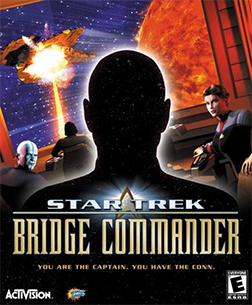
Star Trek: Bridge Commander is a space combat simulation video game for Microsoft Windows, developed by Totally Games and published by Activision in 2002, based in the Star Trek universe.
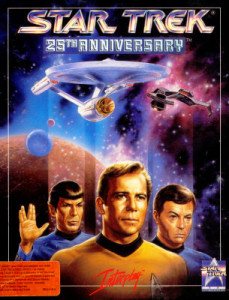
Star Trek: 25th Anniversary is an adventure video game developed and published by Interplay Productions in 1992, based on the Star Trek universe. The game chronicles various missions of James T. Kirk and his crew of the USS Enterprise. Its 1993 sequel, Star Trek: Judgment Rites, continues and concludes this two-game series.

Starscape is a 2D space combat shoot 'em up video game developed by Moonpod games and published in 2003 as shareware. The player character is the sole remaining fighter pilot on the space station Aegis after its warp drive is influenced by aliens, ripping it into another dimension. The objective is to survive and to return.

Starmaster is a video game written for the Atari 2600 by Alan Miller and published in June 1982 by Activision. The game is similar to Atari 8-bit family game Star Raiders. Starmaster was not ported to other systems, but has been re-released in collections such as Activision Anthology.
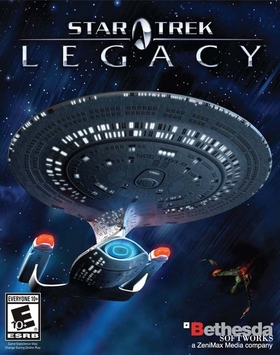
Star Trek: Legacy is a 2006 real-time tactics space combat video game for Microsoft Windows and Xbox 360 developed by Mad Doc Software and published by Bethesda Softworks in association with CBS Paramount Television and CBS Consumer Products. Originally slated for release in the fall of 2006 to coincide with the 40th anniversary of Star Trek, the Windows version was not released in North America until December 5, 2006, and the Xbox 360 version until December 15. In Europe, both the PC version and the Xbox 360 version were released on December 22, 2006.

Star Trek: The Next Generation is a 1994 adventure game developed and published by Spectrum HoloByte. The game features strategy and puzzle-solving elements. The game was released for the Super Nintendo Entertainment System, the Sega Genesis and the Sega Game Gear. It takes place in the Star Trek universe, spanning Federation space and the Romulan Neutral Zone, and centers on the appearance of the IFD, an artifact machine of unknown origin that, as its name suggests, allows its user to reshape matter and energy. It culminates in the IFD Trials, three tests undertaken by representatives of any races that are present when the Trials are held, and failure would mean the destruction of the Federation and the enslavement of countless worlds by the Federation's enemies.

Star Trek: Strategic Operations Simulator is a space combat simulation arcade video game based on the original Star Trek television program and movie series, and released by Sega in 1983. Star Trek uses color vector graphics for both a 2D display and a 3D first-person perspective. The player controls the Starship Enterprise and must defend sectors from invading Klingon ships. The game includes synthesized speech
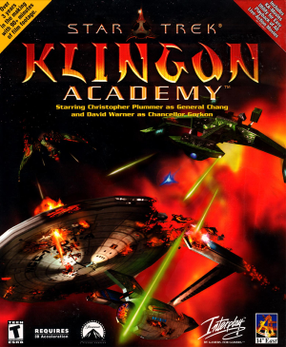
Star Trek: Klingon Academy is a space flight simulator video game developed by 14 Degrees East, an internal development house of publisher Interplay Entertainment. The game follows a young Klingon warrior named Torlek as he attends the Elite Command Academy, a war college created by General Chang to prepare warriors for a future conflict with the United Federation of Planets. Christopher Plummer and David Warner reprised their respective roles as Chang and Gorkon for the production of Klingon Academy.

Star Voyager is an outer space shooter for the Nintendo Entertainment System. The gameplay is a first-person shooter from inside the cockpit of a spaceship. The player navigates "sub spaces" of a larger "world map." Gameplay takes place between different subspaces.
"Persistence of Vision" is the 24th episode of Star Trek: Voyager, the eighth episode in the second season. This science fiction television episode, part of the Star Trek franchise, is several hundred years in the future in Earth's galaxy. A Federation starship is stranded on the other side of the Galaxy, and its warp drive will take decades to return. In this episode, the ship's captain is revealed to be quite stressed and takes some to time to relax in the holodeck. But her experience, in a way typical of this franchise, explores illusion and reality aboard a spaceship encountering unknown aliens.
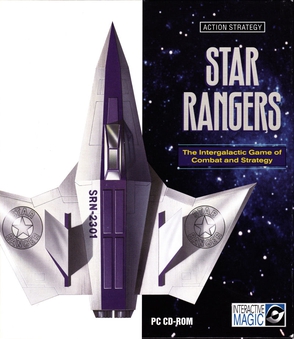
Star Rangers is a space flight simulator and strategy computer game for DOS developed by Interactive Magic and published in October 1995.

Star Trek: Voyager – Elite Force is a first-person shooter video game developed by Raven Software and published by Activision. The game was originally released on September 15, 2000 for Windows and Mac OS. A port for Mac OS developed by Westlake Interactive and published by Aspyr Media was released on November 20, 2002. Elite Force was ported to the PlayStation 2 by Pipe Dream Interactive and published by Majesco Entertainment on December 11, 2001.

Star Trek: The Rebel Universe is an action-adventure computer game published by Firebird Software in Europe and Simon & Schuster Interactive in America. It was originally released for the Atari ST in 1987, and was followed the next year with versions for the Commodore 64 and DOS.

Star Trek: 25th Anniversary is a 1992 Game Boy video game developed by Visual Concepts and published by Ultra, based upon the Star Trek universe. The game chronicles a mission of James T. Kirk and his crew of the USS Enterprise. Despite having the same name, the Game Boy version is not a port of the NES game or computer versions, and is in fact a completely different game. It was succeeded by Star Trek: The Next Generation for Game Boy, developed and published by Absolute Entertainment the following year.
Pocket Fleet is a space themed MOBA game developed by Turkish studio 'Overdose Caffeine Games'. The Android version was released in September 2012. followed by iOS and Flash versions. An Ouya port was also planned initially but abandoned due to porting difficulties. The game features arena type PvP and PvE game play using Asteroids-like game mechanics.

PULSAR: Lost Colony is a science fiction space exploration video game being developed by independent developers Leafy Games, LLC. The video game was greenlit on Steam Greenlight on October 3, 2013, and was later funded successfully on Kickstarter on October 31, 2013. The game was released in an Alpha state on February 25, 2014, and was later available on Steam's Early Access program following an official release on June 23, 2021.

Star Trek: Bridge Crew is a virtual-reality action-adventure video game developed by Red Storm Entertainment and published by Ubisoft for Microsoft Windows, PlayStation 4, and Oculus Quest.

Star Conflict is a free-to-play dynamic massively multiplayer online space action game. The gaming platform Steam describes it as an "action-packed, massively multiplayer space simulation game". The core of the game is PvP spaceships battles, PvE (Co-Op) missions and an open world. The game uses a free-to-play business model.















